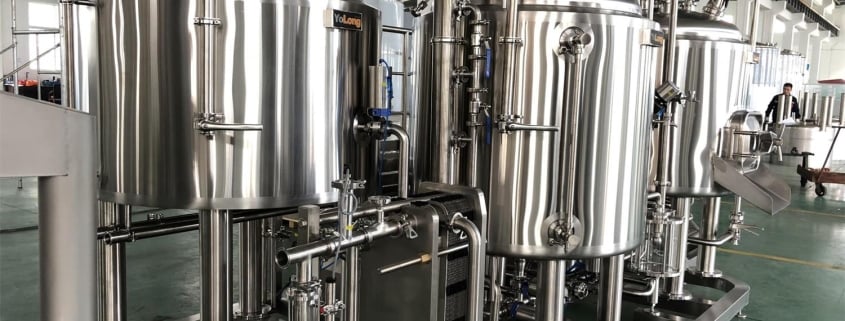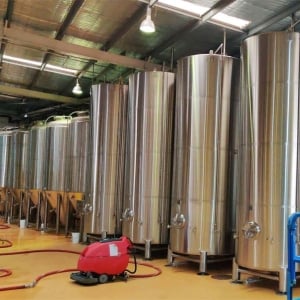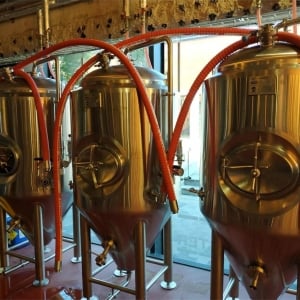Beer Fermentation Tanks
Imagine this: you’ve spent hours meticulously crafting your wort, the sweet, pre-beer liquid that forms the foundation of your favorite beverage. The hops have been meticulously measured, the grains perfectly mashed, and the wort is now cooled and ready for the next crucial step: fermentation. This is where the magic happens, and the unassuming vessel known as the fermentation tank takes center stage.
A Guide to Beer Fermentation Tanks
Fermentation tanks are the workhorses of the brewing process. They provide a sterile, controlled environment for yeast to transform your wort into beer. These tanks come in various shapes, sizes, and materials, each with its own advantages and considerations. Let’s delve into the most common types:
| Fermentation Tank Type | Description | Advantages | Considerations |
|---|---|---|---|
| Cylindrical Fermenters (Unitanks) | These vertical tanks are the industry standard, offering a sleek and space-saving design. | Simple to use Easy to clean Efficient fermentation | Can be pricier May require additional equipment for transferring yeast sediment |
| Conical Fermenters | Featuring a cone-shaped bottom, these tanks allow for easier yeast collection and clearer beer. | Excellent for separating yeast sediment Produces clearer beer Versatile for various beer styles | Slightly more complex to clean May occupy more floor space |
| Plastic Fermenters | These affordable tanks are a popular choice for homebrewers due to their lower cost and light weight. | Budget-friendly Lightweight and easy to maneuver Great for homebrewing | May be susceptible to scratches and staining Not ideal for high-pressure fermentation |
| Stainless Steel Fermenters | The industry standard for professional breweries, these tanks offer superior durability and hygiene. | Durable and long-lasting Easy to clean and sanitize Ideal for large-scale production | Higher initial investment Heavier weight requires sturdier support |
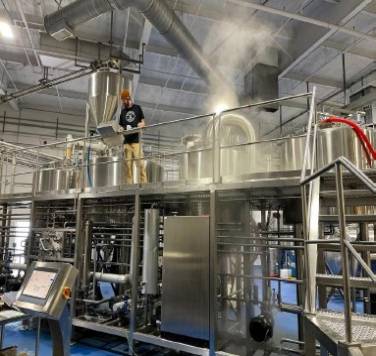
Understanding the Fermentation Process
Within the confines of the fermentation tank, a beautiful biological dance unfolds. Here’s a simplified breakdown of the process:
- Pitching Yeast: You introduce specially selected yeast strains to the wort. These microscopic organisms are the rockstars of beer production, consuming the wort’s sugars and converting them into alcohol and carbon dioxide.
- Krausen Formation: As the yeast actively ferments, a foamy layer called the “krausen” forms on the beer’s surface. This is a sign of healthy fermentation and indicates vigorous yeast activity.
- Primary Fermentation: During this stage, the majority of the sugars are converted into alcohol and CO2. The temperature within the tank is carefully controlled to influence the final beer’s flavor profile.
- Secondary Fermentation (Optional): Some beer styles benefit from a secondary fermentation, where the beer is transferred to another tank for further conditioning and clarification.
- Packaging: Once fermentation is complete, the beer is chilled, filtered (optional), carbonated, and packaged into kegs or bottles for your enjoyment!
Choosing the Perfect Tank: Capacity, Space, Design, and Customization
Selecting the ideal fermentation tank hinges on several factors. Here’s a breakdown to consider:
| Factor | Description | Considerations |
|---|---|---|
| Capacity | This refers to the volume of beer the tank can hold. Homebrewers typically start with smaller tanks (1-5 gallons), while commercial breweries use much larger ones (hundreds or even thousands of gallons). | Consider your batch size and production goals. |
| Available Space | Measure your brewing area and ensure the chosen tank fits comfortably. Account for headspace and clearance for hoses and valves. | Compact conical tanks might be ideal for limited spaces. |
| Design | Cylindrical tanks offer a classic design, while conical tanks provide better yeast collection. Consider features like pressure capabilities and integrated cooling jackets. | Define your brewing style and desired functionalities. |
| Customization | Some manufacturers offer custom tank options, including specific sizes, materials, and additional ports for accessories. | Explore customization options if you have specific brewing needs. |
the Price Range of Beer Fermentation Tanks
The cost of a fermentation tank varies depending on size, material, features, and brand. Here’s a general breakdown to provide a starting point:
| Tank Type | Size (Gallons) | Price Range (USD) |
|---|---|---|
| Homebrew Stainless Steel Fermenters | 5-15 | $100-$500 |
| Commercial Cylindrical Fermenters (Unitanks) | 100-1000 | $2,000-$20,000 |
| Commercial Conical Fermenters | 100-1000 | $3,000-$30,000 |
Suppliers and Distributors
Finding the perfect supplier for your fermentation tank is crucial. Here are some reputable names to consider, but always conduct your research to find the best fit for your needs:
- Northern Brewer offers a wide selection of homebrew equipment, including various sizes and types of fermentation tanks from brands like Speidel, SS Brewing Technologies, and Fermzilla.
- Glacier Tanks caters to both homebrewers and professional breweries, offering custom-sized jacketed conical tanks and unitanks.
- Midwest Supplies is a one-stop shop for brewing equipment and supplies, including a variety of fermentation tanks from reputable manufacturers.
- Brewmation specializes in high-quality brewing equipment for professional breweries, including jacketed conical tanks with advanced features.
Installation, Operation, and Maintenance
Proper installation, operation, and maintenance of your fermentation tank are paramount for successful brewing. Here’s a quick guide:
| Task | Description | Tips |
|---|---|---|
| Installation | Ensure the tank is placed on a level, stable surface that can support its weight. Follow the manufacturer’s instructions for connecting hoses, valves, and any additional equipment. | For larger tanks, professional installation might be recommended. |
| Operation | Sanitize the tank thoroughly before use. Control the fermentation temperature according to your chosen yeast strain and desired beer style. Monitor the progress of fermentation using a hydrometer to measure sugar content. | Invest in a temperature control system for consistent fermentation. |
| Maintenance | Clean and sanitize the tank meticulously after each use. Regularly inspect hoses, valves, and gaskets for wear and tear. | Develop a cleaning routine to ensure optimal hygiene and prevent contamination. |
Choosing the Right Supplier
Selecting the right supplier for your fermentation tank requires careful consideration. Here are some key factors to ponder:
| Factor | Description | Importance |
|---|---|---|
| Reputation | Research the supplier’s reputation for quality products, customer service, and after-sales support. | Look for positive reviews and testimonials from other brewers. |
| Product Selection | Ensure the supplier offers a variety of tanks that meet your size, material, and functionality requirements. | Consider if they offer customization options. |
| Pricing | Compare prices from different suppliers while keeping quality and value in mind. | Don’t be afraid to negotiate, especially for larger purchases. |
| Shipping and Lead Times | Factor in shipping costs and lead times, especially if you require a tank urgently. | Local suppliers might offer faster turnaround times. |
the Pros and Cons of beer fermentation tanks
Pros:
- Control: Fermentation tanks allow you to precisely control the fermentation temperature, leading to a more consistent and predictable final product.
- Quality: Proper fermentation plays a vital role in beer quality. Fermentation tanks provide a sterile environment for yeast to work its magic, resulting in a cleaner and more flavorful beer.
- Efficiency: Compared to open fermentation methods, tanks minimize the risk of contamination and allow for easier transfer and racking of beer.
- Scalability: As your brewing ambitions grow, you can upgrade to larger fermentation tanks to accommodate bigger batches.
Cons:
- Cost: Fermentation tanks, particularly for commercial breweries, can be a significant investment.
- Space: Larger tanks require dedicated space, which might be limited for some homebrewers.
- Complexity: Operating and maintaining fermentation tanks, especially those with advanced features, requires a learning curve.
- Cleaning: Thorough cleaning and sanitation are essential to prevent contamination, which can be time-consuming for larger tanks.
Ultimately, the decision to invest in a fermentation tank depends on your brewing goals, budget, and available space. For homebrewers starting small, simpler options like carboys might suffice. However, for those seeking more control, consistency, and the ability to scale up production, fermentation tanks offer a valuable tool to elevate your brewing experience.
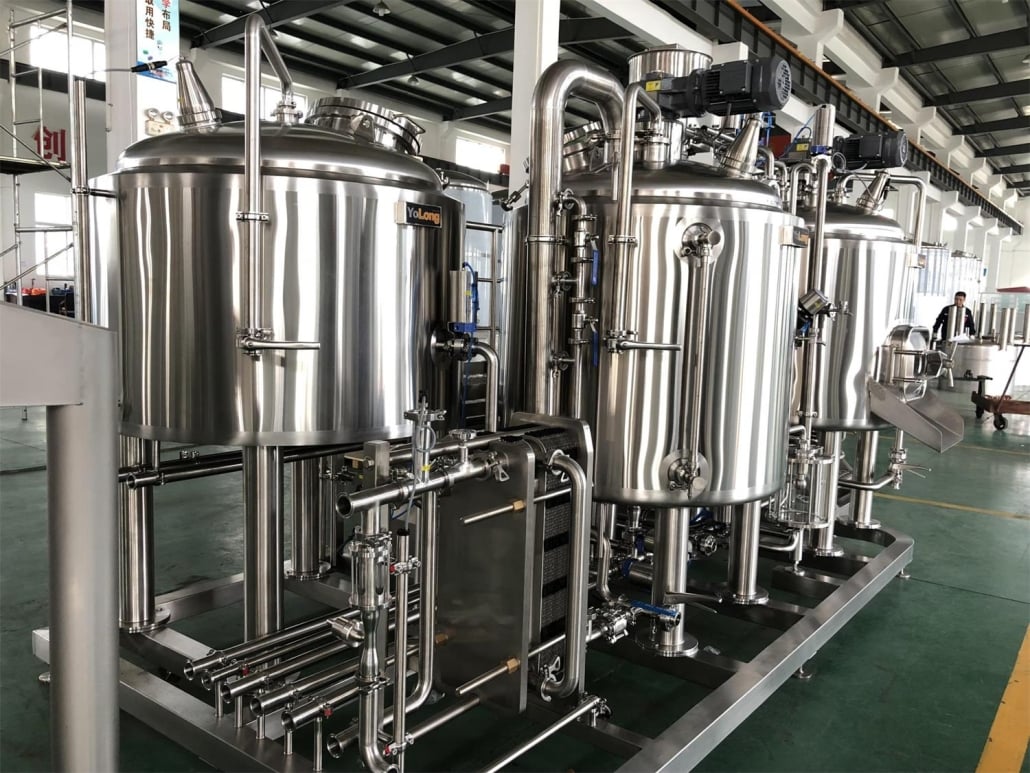
FAQs
| Question | Answer |
|---|---|
| What is the difference between a unitank and a fermenter? | Unitanks (also known as combi tanks) combine fermentation and serving functions into a single vessel. They feature a cylindrical body and a conical bottom for collecting yeast sediment. While fermenters are solely dedicated to the fermentation process. |
| Do I need a pressure-rated fermentation tank? | Pressure-rated tanks allow you to control the CO2 produced during fermentation and carbonate your beer within the tank itself. This can be beneficial for certain beer styles and streamlining the brewing process. However, for many homebrewers, non-pressure rated tanks are perfectly adequate. |
| How long does it take to ferment beer in a tank? | Fermentation time varies depending on the yeast strain, beer style, and fermentation temperature. Typically, ales ferment for 5-7 days, while lagers can take 2-3 weeks or even longer for colder fermentation. |
| Can I use a plastic bucket as a fermentation tank? | Technically, yes. Food-grade plastic buckets can be used for homebrewing on a small scale. However, they are more prone to scratches and staining, and temperature control might be more challenging. Upgrading to a dedicated fermentation tank is recommended for serious homebrewers seeking improved quality and control. |
| What safety precautions should I take when using a fermentation tank? | Sanitation is paramount to prevent contamination. Always sanitize your tank and equipment thoroughly before use. Be cautious when working with pressurized tanks and ensure they are properly rated for the intended pressure. |
Conclusion
Fermentation tanks are the unsung heroes of the brewing process, transforming wort into the delightful beverage we know and love. By understanding the different types, functionalities, and considerations involved, you can select the ideal tank to elevate your brewing experience. Whether you’re a homebrewer yearning for more control or an aspiring brewery owner laying the foundation for success, the perfect fermentation tank awaits to help you craft exceptional beers.

